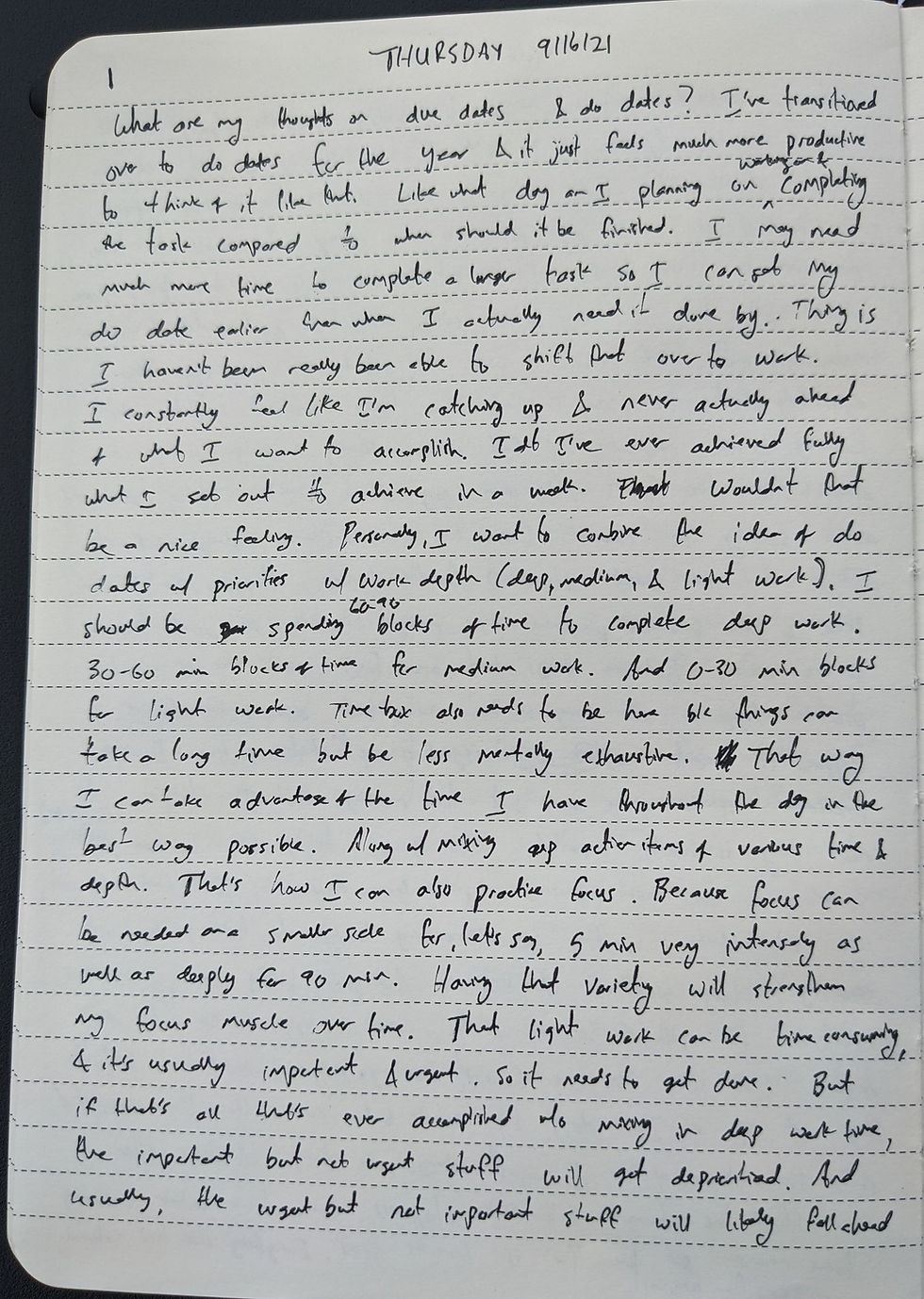What are my thoughts on due dates and do dates? I've transitioned over to do dates for the year and it just feels much more productive to think of it like that. Like what day am I planning on working on and completing the task compared to when should it be finished. I may need much more time to complete a larger task so I can set my do date earlier than when I actually need it done by. Thing is I haven't been really able to shift that over to work. I constantly feel like I'm catching up and never actually ahead of what I want to accomplish. I don't think I've ever achieved fully what I set out to achieve in a week. Wouldn't that be a nice feeling.
Personally, I want to combine the idea of do dates with priority with work depth (deep, medium, and light work). I should be spending 60-90 min blocks of time to complete deep work. 30-60 min blocks of time for medium work. And 0-30 min blocks for light work. Time box also needs to be here because things can take a long time but be less mentally exhaustive. That way I can take advantage of the time I have throughout the day in the best way possible. Along with mixing up action items of various time and depth. That's how I can also practice focus. Because focus can be needed on a smaller scale for, let's say, 5 min very intensely as well as deeply for 90 min. Having that variety will strengthen my focus muscle over time. That light work can be time consuming, and it's usually important and urgent. So it needs to get done. But if that's all that's ever accomplished without mixing in deep work time, the important but not urgent stuff will get deprioritized. And usually, the urgent but not important stuf will likely fall ahead of the important but not urgent. Importance is a function of impact or value. Urgency is a function of time. So does priority actually take into account both of these? Let's say importance is on a scale of 0-10. Urgency is also on a 0-10 scale.
[2 hours of sketching, theorizing, analyzing, and deducing. See pics]
Well 2 hours later. Idk what I created. I don't think it has any value. But it was kinda fun going through this exercise. Just realized I unintentionally mathematically and visually proved out exactly what I said I wanted to earlier in this entry. Of combining priority with depth and time-boxing. And the time-box segments of 0<30<60+ were exactly what I initially said also. Practically I just need to identify what do do when.
[30 more min]
So I put in bands separating out numbers in segments of 10. So 0-10, 11-20, 21-30, etc. I'm calling this Optimal Time Management Bands. Which basically means you see how much time you have. Then you round up to the nearest 10, start from the highest priority item and go down the band until you hit the number that you have the time box of. You then do the task that aligns with that priority and depth. Ex: I have 35 min until my next meeting. I go to the 40 band. I start at the top and go down until I have a task that has a priority and depth that is in that band. I then complete that task. Now here the question is, is it worth doing a 5-priority, 10-depth task more than a 10-priority, 4-depth task? I'd say yes, because our time is the most valuable commodity. You are more likely to have 40 min available in the future rather than 50 min. So it's best to allocate the 50 min you have to doing something that would theoretically take 50 min of deep work to accomplish rather than 40 minutes of medium depth work. I could potentially see dividing it by 0<30<60+ bands to accommodate those narrow margin cases that could be argued either way. Now how practical is this to follow precisely in real life? Extremely impractical. However, this is directional in terms of how I should be approaching my overall time and energy management. I could envision myself having something like this printed off at my desk. And having the priority and depth as numerical fields for the task. And then an automatic formula field that has the multiplied total to give the Time-Box score. Of course, this is all under the assumption that each priority and depth product of 1-10 scores correlates exactly to minutes of work. Who knows if that's true or not. If you have more than 100 min, then just start in the 100 and keep going left and progressively through the bands.
Damn this was a ~4 hour journal session. I actually think I created something PhD level in just this one session that started with a single question of do dates and due dates. Anything really is possible.







Commentaires